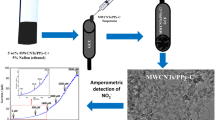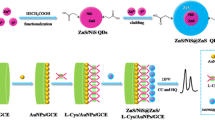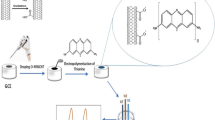Abstract
Tryptophan, an essential amino acid playing a pivotal role in various biological processes, stands as a focal point in our investigation. In this study, we introduce a groundbreaking electrochemical sensor that integrates a nanocomposite comprising carbon black (CB) and zinc oxide nanoparticles (ZnO-NPs) for the selective detection of L-tryptophan (Trp). The synthesis of ZnO-NPs, accomplished through the sol-gel technique, was meticulously characterized using XRD, FTIR, and UV-visible methods to unveil their structural and optical properties. The construction of the sensing electrode involved the deposition of a CB/ZnO-NP nanocomposite onto a glassy carbon electrode (GCE) utilizing the drop-coating method. Rigorous evaluation and analysis of the modified glassy carbon electrode were carried out through scanning electron microscopy (SEM), cyclic voltammetry (CV), and differential pulse voltammetry (DPV). The resulting CB/ZnO-NPs/GCE electrode exhibited an augmented surface area and outstanding electrocatalytic activity. Significantly, the CB/ZnO-NP sensor displayed remarkable analytical performance for tryptophan detection over an extensive concentration range from 0.01 to 100 µmol.L−1, featuring a low detection limit of 0.017 µmol.L−1. Moreover, the proposed electrochemical sensor exhibited notable selectivity, specifically targeting tryptophan, emphasizing its potential for diverse analytical applications. This work not only expands our understanding of tryptophan detection but also offers a highly sensitive and selective tool with broad applications in biomedical and environmental fields, underscoring the significance of this innovative sensor in advancing analytical methodologies.










Similar content being viewed by others
References
Sundaresan R, Mariyappan V, Chen SM et al (2021) Electrochemical sensor for detection of tryptophan in the milk sample based on MnWO4 nanoplates encapsulated RGO nanocomposite. Colloids Surf A 625:126889. https://doi.org/10.1016/j.colsurfa.2021.126889
Strasser B, Gostner JM, Fuchs D (2016) Mood, food, and cognition: role of tryptophan and serotonin. Curr Opin Clin Nutr Metab Care 19:55–61. https://doi.org/10.1097/MCO.0000000000000237
Wang Y, Ouyang X, Ding Y et al (2016) An electrochemical sensor for determination of tryptophan in the presence of da based on poly(l-methionine)/graphene modified electrode. RSC Adv 6:10662–10669. https://doi.org/10.1039/c5ra24116b
Keil DE (2013) Amino acids and proteins. Clinical Chemistry: Principles, Techniques, and Correlations: Seventh Edition 202–245. https://doi.org/10.5005/jp/books/13106_3
Wang L, Yang R, Li J et al (2019) A highly selective and sensitive electrochemical sensor for tryptophan based on the excellent surface adsorption and electrochemical properties of PSS functionalized graphene. Talanta 196:309–316. https://doi.org/10.1016/j.talanta.2018.12.058
Laich A, Neurauter G, Widner B, Fuchs D (2019) More rapid method for simultaneous measurement of tryptophan and kynurenine by HPLC. Clin Chem 48:579–581. https://doi.org/10.1093/clinchem/48.3.579
William N, Magidman P, Harold M (2019) Pyrolysis gas chromatography of wool: part II: detection and quantitation of tryptophan in wool and simple proteins. Text Res J 59:616. https://doi.org/10.1177/0040517589059010
Anderson G, Young J, Cohen D (1979) Rapid liquid chromatographic determination of tryptophan, tyrosine, 5-hydroxyindoleacetic acid and homovanillic acid in cerebrospinal fluid. J Chromatogr A 164:501–505. https://doi.org/10.1016/S0378-4347(00)81553-4
Baranowska I, Kozowska M (1995) TLC separation and derivative spectrophotometry of some amino acids. Talanta 42:1553–1557. https://doi.org/10.1016/0039-9140(95)01569-W
Luethi-Peng Q, Puhan Z (1999) Determination of protein and casein in milk by fourth derivative UV spectrophotometry. Anal Chim Acta 393:227–234. https://doi.org/10.1016/S0003-2670(98)00823-X
Tian Y, Deng P, Wu Y et al (2019) A Simple and Efficient Molecularly Imprinted Electrochemical Sensor for the Selective Determination of Tryptophan. Biomolecules 9:294–311. https://doi.org/10.3390/biom9070294
Echabaane M, Hfaiedh S, Smiri B et al (2021) Development of an impedimetric sensor based on carbon dots and chitosan nanocomposite modified electrode for Cu(II) detection in water. J Solid State Electrochem 25:1797–1806. https://doi.org/10.1007/s10008-021-04949-3
Mahmoud A, Echabaane M, Omri K, ElMir L, Chaabane RB (2019) Development of an impedimetric non enzymatic sensor based on ZnO and Cu doped ZnO nanoparticles for the detection of glucose. J Alloys Compounds 786:960–968. https://doi.org/10.1016/j.jallcom.2019.02.060
Viezbicke BD, Patel S, Davis BE, Birnie DP (2015) Evaluation of the Tauc method for optical absorption edge determination: ZnO thin films as a model system. Phys Status Solidi (B) Basic Res 252:1700–1710. https://doi.org/10.1002/pssb.201552007
El Golli A, Echabaane M, Dridi C (2022) Development of an electrochemical nanoplatform for non-enzymatic glucose sensing based on Cu / ZnO nanocomposite. Mater Chem Phys 280:125844–125854. https://doi.org/10.1016/j.matchemphys.2022.125844
Wu B, Xiao L, Zhang M et al (2021) Facile synthesis of dendritic-like CeO2/rGO composite and application for detection of uric acid and tryptophan simultaneously. J Solid State Chem 296:122023. https://doi.org/10.1016/j.jssc.2021.122023
Sivakumar N, Gajendiran J, Jayavel R (2020) Microstructural, optical, electrochemical and magnetic properties of hydrothermal synthesized zincite/carbon (ZnO/C) composite. Chem Phys Lett 745:137262. https://doi.org/10.1016/j.cplett.2020.137262
Boumeftah A, Belmokhtar A, Benyoucef A (2022) Novel nanocomposites based on poly(4,4′-diaminodiphenyl sulfone) and carbon black-ZnO (CB@ZnO) binary composites: synthesis, characterization, and mechanical, optical and electrochemical properties. Colloid Polym Sci 300:203–212. https://doi.org/10.1007/s00396-022-04944-8
Karami Z, Sheikhshoaie I (2017) rGO/ZnO nanocomposite modified carbon paste electrode as sensor for tyrosine analysis. Anal Bioanal Electrochem 9:834–840
Zhang M, Liu H, Chen L et al (2013) Biosensors and Bioelectronics A disposable electrochemiluminescence device for ultrasensitive monitoring of K562 leukemia cells based on aptamers and ZnO @ carbon quantum dots. Biosens Bioelectron 49:79–85. https://doi.org/10.1016/j.bios.2013.05.003
Rahman M, Alam M, Abdullah A (2018) Carbon black co-adsorbed ZnO nanocomposites for selective benzaldehyde sensor development by electrochemical approach for environmental safety. J Ind Eng Chem 65:300–308. https://doi.org/10.1016/j.jiec.2018.04.041
Ahmed J, Faisal M, Jalalah M, Alsareii SA, Harraz FA (2021) Novel polypyrrole-carbon black doped ZnO nanocomposite for efficient amperometric detection of hydroquinone. J Electroanal Chem 898:115631–115643. https://doi.org/10.1016/j.jelechem.2021.115631
Arumugam B, Annaraj J, Nagarajan V, Perumal KN, Ramaraj SK (2022) Novel polypyrrole-carbon black doped ZnO nanocomposite for efficient amperometric detection of hydroquinone. Microchem J 175:107202–107212. https://doi.org/10.1016/j.microc.2022.107202
Owens JG, Singh KR, Foroutan F et al (2016) Sol–gel based materials for biomedical applications. Adv Mater Sci Eng 77:1–79. https://doi.org/10.1016/j.colsurfa.2021.126889
Mahmoud A, Echabaane M, Omri K et al (2021) Cu-doped ZnO nanoparticles for non-enzymatic glucose sensing. Mol 26:929–948. https://doi.org/10.3390/molecules26040929
Jayachandran A, Aswathy TR, Nair AS (2021) Green synthesis and characterization of zinc oxide nanoparticles using Cayratia pedata leaf extract. Biochem Biophys 26:100995–101003. https://doi.org/10.1016/j.bbrep.2021.100995
El Ghoul J, Barthou C, Saadoun M, El Mir L (2010) Synthesis and optical characterization of SiO2/Zn2SiO4: Mn nanocomposite. Physica B Condens Matter 405:597–601. https://doi.org/10.1016/j.physb.2009.09.072
Xiong G, Pal U, Serrano JG et al (2006) Photoluminescence and FTIR study of ZnO nanoparticles: the impurity and defect perspective. Phys Status Solidi (C) Curr Top Solid State Phys 3:3577–3581. https://doi.org/10.1002/pssc.200672164
Suwanboon S, Amornpitoksuk P, Sukolrat A (2013) Optical and photocatalytic properties of La-doped ZnO nanoparticles prepared via precipitation and mechanical milling method. Ceram Int 39:2811–2819. https://doi.org/10.1016/j.ceramint.2012.09.050
Mallika AN, Ramachandrareddy A, Sowribabu K, Reddy KV (2014) Author ’ s accepted manuscript. Ceram Int. https://doi.org/10.1016/j.ceramint.2014.04.057
Tiwari N, Kumar S, Ghosh AK, Bhattacharyya D (2017) RSC Advances nanocrystals using X-ray absorption studies. RSC Adv 7:56662–56675. https://doi.org/10.1039/C7RA10748J
Dong MW, Yun ZD, Yi L et al (2008) Determination of Thickness and Optical Constants of ZnO Thin Films Prepared by Filtered Cathode Vacuum Arc Deposition. Chin Phys Lett 25:743–746. https://doi.org/10.1088/0256-307X/25/2/106
Wang Y, Li D, Kang J et al (2016) An electrochemical sensor based on MB/Ag-ZnO/graphene modified glassy carbon electrode for determination of L-tryptophan in biofluid samples. Int J Electrochem Sci 14:5448–5461. https://doi.org/10.20964/2019.06.29
Ben Messaoud N, Ghica ME, Dridi C et al (2017) Electrochemical sensor based on multiwalled carbon nanotube and gold nanoparticle modified electrode for the sensitive detection of bisphenol A. Sens Actuators, B Chem 253:513–522. https://doi.org/10.1016/j.snb.2017.06.160
Huang YH, Chen JH, Li Jing Ling LJ et al (2015) Simultaneous electrochemical detection of catechol and hydroquinone based on gold nanoparticles@carbon nanocages modified electrode. Analyst 140:7939–7949. https://doi.org/10.1039/C5AN01738F
Chen B, Xie Q, Zhang S et al (2021) A novel electrochemical molecularly imprinted senor based on CuCo2O4@ biomass derived carbon for sensitive detection of tryptophan. J Electroanal Chem 901:115680. https://doi.org/10.1016/j.jelechem.2021.115680
Zhang S, Ling P, Chen Y et al (2023) 2D/2D porous Co3O4/rGO nanosheets act as an electrochemical sensor for voltammetric tryptophan detection. Diam Relat Mater 135:109811. https://doi.org/10.1016/j.diamond.2023.109811
Amir Poursaeed A, Jahani S, Moradalizadeh M et al (2023) Electrochemical detection of kynurenic acid in the presence of tryptophan with the carbon paste electrode modified with the flower-like nanostructures of zinc oxide doped with terbium. Front Chem 11:1–13. https://doi.org/10.3389/fchem.2023.1250994
Li YJ, Yang LL, Ni L et al (2023) Constructing electrochemical sensor using molecular-imprinted polysaccharide for rapid identification and determination of L-tryptophan in diet. Food Chem 425. https://doi.org/10.1016/j.foodchem.2023.136486
Mahdi N, Roushani M, Karazan ZM (2023) Electrochemical sensor based on molecularly imprinted copolymer for selective and simultaneous determination of riboflavin, dopamine, and L-tryptophan. J Mol Recognit 36. https://doi.org/10.1002/jmr.3053
Abebe HA, Diro A, Kitte SA (2023) Voltammetric determination of tryptophan at graphitic carbon nitride modified carbon paste electrode. Heliyon 9:e21033. https://doi.org/10.1016/j.heliyon.2023.e21033
Kholafazadehastamal G, Khan M, Soylak M, Erk N (2023) Maximizing detection sensitivity of levofloxacin and tryptophan in dairy products: a carbon-based electrochemical sensor incorporating Ti3AlC2 MAX phase and activated nanodiamonds. Carbon Lett. https://doi.org/10.1007/s42823-023-00611-2
Khaleque MA, Bacchu MS, Ali MR et al (2023) Copper oxide nanoflowers/poly-L-glutamic acid modified advanced electrochemical sensor for selective detection of L-tryptophan in real samples. Heliyon 9:e16627. https://doi.org/10.1016/j.heliyon.2023.e16627
Khoshsafar H, Bagheri H, Hashemi P et al (2023) Combination of an aptamer-based immunochromatography assay with nanocomposite-modified screen-printed electrodes for discrimination and simultaneous determination of tryptophan enantiomers. Talanta 253:124090. https://doi.org/10.1016/j.talanta.2022.124090
Rezaei F, Ashraf N, Zohuri GH, Arbab-Zavar MH (2022) Water-compatible synthesis of core-shell polysilicate molecularly imprinted polymer on polyvinylpyrrolidone capped gold nanoparticles for electrochemical sensing of uric acid. Microchem J 177:107312. https://doi.org/10.1016/j.microc.2022.107312
Yıldız C, Eskiköy Bayraktepe D, Yazan Z (2020) Electrochemical low-level detection of L-tryptophan in human urine samples: use of pencil graphite leads as electrodes for a fast and cost-effective voltammetric method. Monatsh Chem 151:871. https://doi.org/10.1007/s00706-020-02620-7
Funding
This research is backed by MESRS in Tunisia and MENFPESRS in Morocco, as part of the Tunisian-Moroccan collaborative RD project 20/PRD-17 (SMARTANTICANCER). Their support has been instrumental in funding Ms. BLEL’s internship in Morocco and in facilitating the Eranetmed NanoSWS project.
Author information
Authors and Affiliations
Corresponding authors
Additional information
Publisher's Note
Springer Nature remains neutral with regard to jurisdictional claims in published maps and institutional affiliations.
Rights and permissions
Springer Nature or its licensor (e.g. a society or other partner) holds exclusive rights to this article under a publishing agreement with the author(s) or other rightsholder(s); author self-archiving of the accepted manuscript version of this article is solely governed by the terms of such publishing agreement and applicable law.
About this article
Cite this article
Blel, A., Echabaane, M. & Dridi, C. Development of an electrochemical nanoplatform based on ZnO nanoparticles and carbon black nanocomposite for the detection of tryptophan. J Solid State Electrochem (2024). https://doi.org/10.1007/s10008-024-05830-9
Received:
Revised:
Accepted:
Published:
DOI: https://doi.org/10.1007/s10008-024-05830-9




